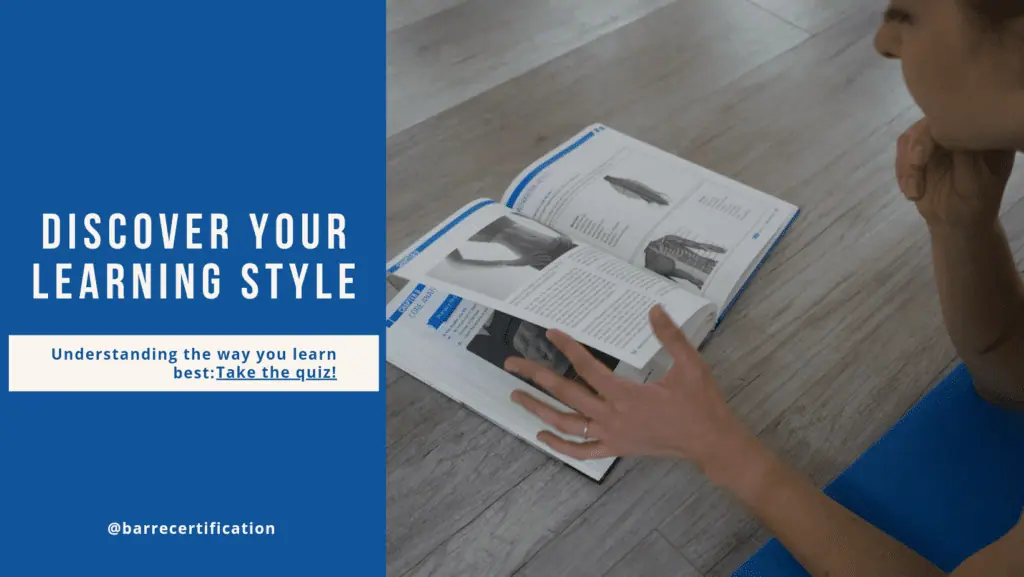
There’s a lot to learn in the IBBFA training manual. We learn about counting music, how to cue exercises, ballet terminology, as well as how and when to give students modifications and challenges.
Utilizing different learning styles is key to finding success as you go through your instructor training. There are seven different learning styles, they are: auditory, visual, tactile (kinesthetic), verbal, logical, social and solitary. So, what type of learner are you?
If you don’t already know your preferred learning style, take a short quiz online (we use this one) to discover your learning tendencies. Knowing what learning methods work best for you will help you make sense of what you are learning and help retain the material better.
Read each of the seven learning styles below to see which one(s*) is a good fit for you.
*It’s possible more than one option applies to you!
Auditory learners
You think the videos and lectures provided in the Barre Level 1 online course are super helpful!
Tips: To help guide you through the material, you may want to skim the written material first, watch all related videos second, and then closely read through the material again to catch things you missed before.
When teaching, it may be helpful to record your class and listen to the cues you provide. Make sure they are clear and audible trough the entire class.
Visual learners
The photographs in the manual help you make sense of it all.
Tips: Use the photographs in the Level 1 manual to help guide through the step-by-step instructions for each exercise.
When building a class outline, use visual cues like arrows or brackets to inform you how the class flow will go. Creating more of a flow chart than traditional outline may make it easier for you to keep track during your classes.
Tactile learners
You can’t learn a new exercise without trying it out yourself.
Tips: When going through the learning materials in your instructor training, you may want to clear out some space to actually perform the exercises when learning how to set up, modify and correct errors.
This is also a helpful learning style as a student. Remember to take some time to allow students to feel and really notice the difference between correct and incorrect form.
Here’s an example an exercise to help student find proper alignment:
1. Have the student stand in a parallel position and arch their back so the tailbone reaches backwards.
2.Tuck the pelvis to reach the tailbone under the body and then forward.
3. Finally, have students find a middle ground where the tailbone is heavy to the floor and the spine is in a neutral position.
If you tried the exercise after reading, you are probably a tactile learner.
Verbal learners
Are you reading this aloud or to a friend?
Tips: If you are a verbal learner, you may enjoy going through the program with another instructor. Discuss each chapter and ask questions along the way.
Since the IBBFA barre certification program is 100% online, you may find the support team to be beneficial. You can call or email them with any questions at: +1 (888)-215-0101 or support@barrecertification.com.
Logical learners
The anatomical explanations of the exercises and postures are your favorite part of the IBBFA manual.
Tips: Logical learners tend to find patterns or reason in what they are learning. Many instructor trainings simply provide choreography with no reason for why an exercise works targeted muscles. As a logical learner, be sure you understand why exercises are set up in certain ways. You will learn how to set up from the ground up. Perhaps flashcards with quick set-ups and targeted body parts will help you keep track of the many variations for each exercise.
Your class structure should have some reason and familiarity to it too. When you begin to design your classes, keep things consistent. Students will appreciate the ability to know what to expect in class.
Social learners
You believe one of the best ways to train as instructor is to put yourself in the shoes of your students.
Tips: One of the final steps to becoming barre certified is to film yourself teaching a mock class with one student. Make this a fun event for the student you choose. Many people are nervous when teaching in front of a camera but use your student to provide feedback. Use someone you trust who will put energy into this experience. You only need to submit video footage of the actual exercises, but use the time with your student to test out different cues or phrases.
You can also take barre classes taught by other instructors. Stay after class to bounce ideas off one another and ask questions.
Solitary learners
You appreciate IBBFA’s self-paced, online course.
Tips: You will appreciate the individualized feedback after you submit your practical video exam. If you’ve already completed the course, go back and look at the reviewer’s comments every once and while and see what you can apply to your class.
Trust your gut. Your attention to detail allows you to anticipate the needs of your students and provide modification options throughout class.
So what do you think? Let us know how your instructor training is going, and if knowing your learning style has helped you find success.

